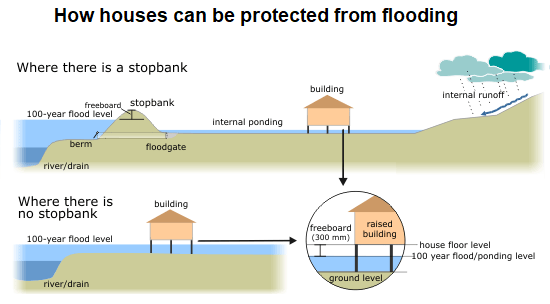5+ The diagrams below show how houses can be protected in areas which are prone to flooding
The diagrams below show how houses can be protected in areas which are prone to flooding. Summarise the information by selecting and reporting the main features, and make comparisons where relevant. Write at least 150 words hay nhất giúp bạn có thêm tài liệu tham khảo để viết bài luận bằng Tiếng Anh hay hơn.
- The diagrams below show how houses can be protected in areas which are prone to flooding (mẫu 1)
- The diagrams below show how houses can be protected in areas which are prone to flooding (mẫu 2)
- The diagrams below show how houses can be protected in areas which are prone to flooding (mẫu 3)
- The diagrams below show how houses can be protected in areas which are prone to flooding (mẫu 4)
- The diagrams below show how houses can be protected in areas which are prone to flooding (mẫu 5)
- The diagrams below show how houses can be protected in areas which are prone to flooding (mẫu 6)
5+ The diagrams below show how houses can be protected in areas which are prone to flooding
Đề bài: The diagrams below show how houses can be protected in areas which are prone to flooding. Summarise the information by selecting and reporting the main features, and make comparisons where relevant. Write at least 150 words.

The diagrams below show how houses can be protected in areas which are prone to flooding - mẫu 1
The diagrams compare two different methods of defence for homes which are at risk of being flooded.
The key difference between the diagrams is that they show flood protection with and without a stopbank. In either case, the at-risk home is raised on stilts above ground level.
The first diagram shows how a stopbank acts as a flood barrier to stop river water from flooding homes. The stopbank is a small mound of land next to the river that is higher than the 100-year flood level and prevents the river from bursting its banks. Nearby houses can be built on stilts to prevent flooding from rainwater, and a floodgate beneath the stopbank can be opened to allow this 'ponding' to drain off into the river.
When there is no stopbank, as shown in the second diagram, there will be nothing to stop the river from flooding. In this case, the solution is to put buildings on stilts. The height of the stilts is measured so that the floor of the house is 300mm above the 100-year flood level. This measurement is called the 'freeboard'.
The diagrams below show how houses can be protected in areas which are prone to flooding - mẫu 2
The process diagram illustrates the methods of protesting buildings in regions predisposed to flooding. Overall, it can be seen that stopbank may and may not be utilised to prevent floods.
To begin with, where there is a stopbank, internal runoff from heavy downpours of rain is flooded toward the house area. The construction of houses was raised to a standard height to allow internal ponding.
Next, at the junction of the stopbank is a floodgate that controls the inward and outward flow of water. Following this, the freeboard is situated at the stopbank’s point, which permits a 100-year flood level. Then the berm allows easy river drainage without causing the house’s collapse.
Converse, where there is no stop bank, houses are constructed with a freeboard of 300mm height and are adequately raised above the ground level. After this, 100 years flood level is achieved, thus preventing the house from being pulled down by the flood. The water is then drained toward the riverside.
The diagrams below show how houses can be protected in areas which are prone to flooding - mẫu 3
The diagram displays the protection of dwelling units in places that are likely to be flooded. In all, there are two ways to ensure this.
Overall, it is noticeable that there are two primary methods for preventing buildings situated in flooding areas.
Firstly, there is the one which involves the use of a stopbank. With this method, a structure that looks like a mountain, known as a stopbank, is erected between the housing units and the location of the 100-year flood level. Specifically speaking, the stopbank consists of a device called the freeboard.
It also has a berm bank of earth and a floodgate which all operate to prevent the influx of flood water into housing units. Moreover, the building has been raised with some structures to suspend it above ground level, preventing internal runoff rainwater from entering building structures.
The second structure is without a stopbank, so the 100-year water flows directly into the housing area. With this, the house has to be raised with systems that will enable the housing units to be positioned above the ponding level at 300mm. This helps to prevent a direct influx of flood water into the vicinity.
The diagrams below show how houses can be protected in areas which are prone to flooding - mẫu 4
The diagram illustrates the floodplain management to protect buildings from flooding in flood-prone areas with two protective methods. The trend suggests that two options for flood management are given, one with a stopbank and one without a stopbank.
The first diagram shows the option with a stopbank. This type of flooding occurs when runoff from heavy or widespread rainfall raises the water level and as it continues to rise, the berm angel of the stopbank holds back the rising water. It is constructed above the 100-year high watermark for consistent control at the highest levels ever recorded. A floodgate has also been constructed at the bottom of the stopbank so excess water can be drained from the internal ponding area, with the building being built on stilts to allow for the flow of water under it.
The second diagram shows the option where there is no stopbank. For this diagram, the 100-year water level is considered into the construction level of the building’s stilts, being just a bit higher than this level to protect against flood damage. No berm or floodgate has been constructed. The freeboard is 300mm higher than the 100-year flood level, and the building itself is raised a bit more compared to the diagram with a stopbank.
In conclusion, two floodplain management diagrams have been shown, one with a stopbank, and one where no stopbank has been made.
The diagrams below show how houses can be protected in areas which are prone to flooding - mẫu 5
The provided images illustrate how buildings can be protected in flood-prone locations. Overall, there are two methods to safeguard houses: with and without stopbanks.
Looking at the first diagram, a large stopbank is created on the left side of the building, and on the right side, internal runoff comes from the clouds. The building is situated in the centre of these two, where an internal ponding area is formed. Moreover, floodgates are available at the stopbank, which releases internal ponding water into the river.
In the second image, a building is located near the river, and no stopbank is constructed. In this case, the building is raised 300 mm above the water level, and the 100-year flood/ponding level remains below the house floor level.
The diagrams below show how houses can be protected in areas which are prone to flooding - mẫu 6
This diagram compares two different defence methods for homes at risk for flooding.
The main difference in both diagrams is slowing down the flood level by using a stopbank, while in another case, instead of using a stopbank, building the house at the risk of high water level.
This first picture shows how a stopbank is used as a protective barrier to stop river water from flooding homes. The stopbank is placed next to the riverbank, which is higher than the 100-year flood level, preventing the house from bursting. And nearby houses are built on stilts to prevent flooding water from rainwater, and a floodgate beneath the stopbank can be opened to allow this ponding to drain off into the river.
In the second diagram, without any stopbank, there will be nothing to stop the water from flooding. In this scenario, the solution is to build houses on stilts. The height of the house should be higher than the river water level, approx. 300mm. This measurement is known as the “freeboard” system.
Xem thêm các bài luận Tiếng Anh hay khác:
Đã có app VietJack trên điện thoại, giải bài tập SGK, SBT Soạn văn, Văn mẫu, Thi online, Bài giảng....miễn phí. Tải ngay ứng dụng trên Android và iOS.
Theo dõi chúng tôi miễn phí trên mạng xã hội facebook và youtube:Nếu thấy hay, hãy động viên và chia sẻ nhé! Các bình luận không phù hợp với nội quy bình luận trang web sẽ bị cấm bình luận vĩnh viễn.
- Đề thi lớp 1 (các môn học)
- Đề thi lớp 2 (các môn học)
- Đề thi lớp 3 (các môn học)
- Đề thi lớp 4 (các môn học)
- Đề thi lớp 5 (các môn học)
- Đề thi lớp 6 (các môn học)
- Đề thi lớp 7 (các môn học)
- Đề thi lớp 8 (các môn học)
- Đề thi lớp 9 (các môn học)
- Đề thi lớp 10 (các môn học)
- Đề thi lớp 11 (các môn học)
- Đề thi lớp 12 (các môn học)
- Giáo án lớp 1 (các môn học)
- Giáo án lớp 2 (các môn học)
- Giáo án lớp 3 (các môn học)
- Giáo án lớp 4 (các môn học)
- Giáo án lớp 5 (các môn học)
- Giáo án lớp 6 (các môn học)
- Giáo án lớp 7 (các môn học)
- Giáo án lớp 8 (các môn học)
- Giáo án lớp 9 (các môn học)
- Giáo án lớp 10 (các môn học)
- Giáo án lớp 11 (các môn học)
- Giáo án lớp 12 (các môn học)





 Giải bài tập SGK & SBT
Giải bài tập SGK & SBT
 Tài liệu giáo viên
Tài liệu giáo viên
 Sách
Sách
 Khóa học
Khóa học
 Thi online
Thi online
 Hỏi đáp
Hỏi đáp

